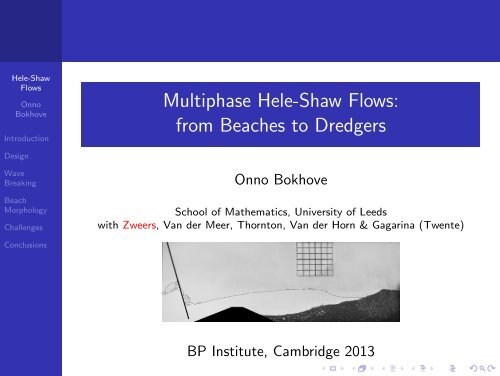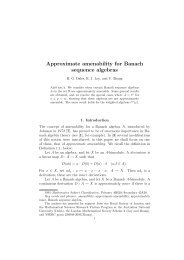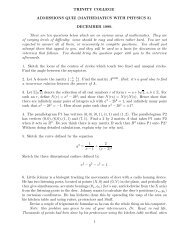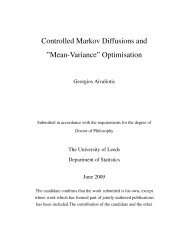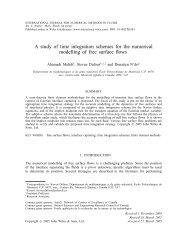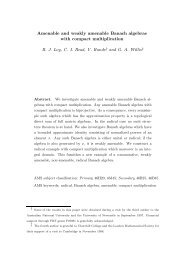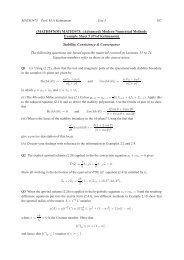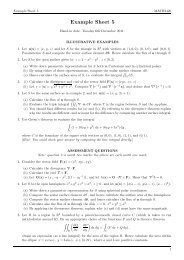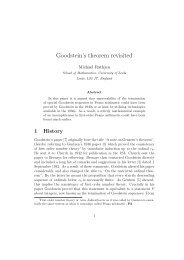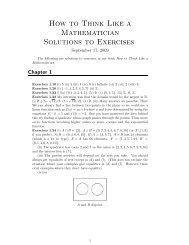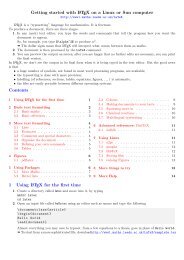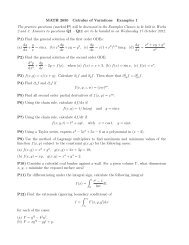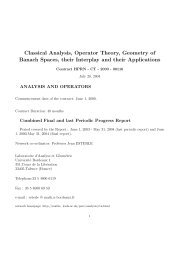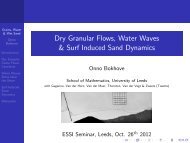Multiphase Hele-Shaw Flows: from Beaches to Dredgers - School of ...
Multiphase Hele-Shaw Flows: from Beaches to Dredgers - School of ...
Multiphase Hele-Shaw Flows: from Beaches to Dredgers - School of ...
Create successful ePaper yourself
Turn your PDF publications into a flip-book with our unique Google optimized e-Paper software.
<strong>Hele</strong>-<strong>Shaw</strong><br />
<strong>Flows</strong><br />
Onno<br />
Bokhove<br />
Introduction<br />
<strong>Multiphase</strong> <strong>Hele</strong>-<strong>Shaw</strong> <strong>Flows</strong>:<br />
<strong>from</strong> <strong>Beaches</strong> <strong>to</strong> <strong>Dredgers</strong><br />
Design<br />
Wave<br />
Breaking<br />
Beach<br />
Morphology<br />
Challenges<br />
Onno Bokhove<br />
<strong>School</strong> <strong>of</strong> Mathematics, University <strong>of</strong> Leeds<br />
with Zweers, Van der Meer, Thorn<strong>to</strong>n, Van der Horn & Gagarina (Twente)<br />
Conclusions<br />
BP Institute, Cambridge 2013
<strong>Hele</strong>-<strong>Shaw</strong><br />
<strong>Flows</strong><br />
Onno<br />
Bokhove<br />
Introduction<br />
Design<br />
Wave<br />
Breaking<br />
Beach<br />
Morphology<br />
Challenges<br />
Conclusions<br />
1 Introduction<br />
2 Design<br />
3 Wave Breaking<br />
4 Beach Morphology<br />
5 Challenges<br />
6 Conclusions
1. Introduction<br />
<strong>Hele</strong>-<strong>Shaw</strong><br />
<strong>Flows</strong><br />
Onno<br />
Bokhove<br />
Introduction<br />
Design<br />
Wave<br />
Breaking<br />
Beach<br />
Morphology<br />
Challenges<br />
Conclusions<br />
<strong>Multiphase</strong> <strong>Hele</strong>-<strong>Shaw</strong> flows:<br />
Particles, water & air: beach dynamics by breaking waves.<br />
Particles & air: aeolean poppy seed dunes [movie].<br />
Particles, water & a pump: dredging [design].
<strong>Hele</strong>-<strong>Shaw</strong> Beach Dynamics<br />
<strong>Hele</strong>-<strong>Shaw</strong><br />
<strong>Flows</strong><br />
Onno<br />
Bokhove<br />
Introduction<br />
Design<br />
Wave<br />
Breaking<br />
Beach<br />
Morphology<br />
Challenges<br />
Conclusions<br />
Create manageable mathematical/labora<strong>to</strong>ry environment <strong>of</strong><br />
beach dynamics:<br />
Wave action, during s<strong>to</strong>rms, drives the evolution <strong>of</strong><br />
beaches.<br />
Beach evolution by breaking waves poorly unders<strong>to</strong>od.<br />
Equations water, air, particles available: DNS <strong>to</strong>o costly.<br />
Modeling environment should include hierarchy <strong>of</strong> models.
<strong>Hele</strong>-<strong>Shaw</strong> Beach Dynamics<br />
<strong>Hele</strong>-<strong>Shaw</strong><br />
<strong>Flows</strong><br />
Onno<br />
Bokhove<br />
Introduction<br />
Design<br />
Wave<br />
Breaking<br />
Beach<br />
Morphology<br />
Challenges<br />
Conclusions<br />
Design:<br />
Imagine you have a giant’s knife, make cuts <strong>to</strong> isolate a<br />
slice <strong>of</strong> beach . . . including sand & water, particle and<br />
wave motion.<br />
Place slice between glass plates & shrink <strong>to</strong> table-<strong>to</strong>p size.<br />
<strong>Beaches</strong>, berms & sand bars emerge in min/hr by waves<br />
with wave forcing T ≈ 1s.
Sketch <strong>Hele</strong>-<strong>Shaw</strong> beach<br />
<strong>Hele</strong>-<strong>Shaw</strong><br />
<strong>Flows</strong><br />
Onno<br />
Bokhove<br />
Introduction<br />
z<br />
wave−maker<br />
g<br />
Design<br />
Wave<br />
Breaking<br />
Beach<br />
Morphology<br />
Challenges<br />
Conclusions<br />
l<br />
p<br />
θ w<br />
wedge<br />
0 x l<br />
L<br />
w w<br />
x<br />
Sketch <strong>Hele</strong>-<strong>Shaw</strong> cell: wedge, waterline, particles &<br />
wave-maker.<br />
B 0<br />
free surface<br />
H 0<br />
particles
(Dis)Advantages <strong>Hele</strong>-<strong>Shaw</strong> Beach<br />
<strong>Hele</strong>-<strong>Shaw</strong><br />
<strong>Flows</strong><br />
Onno<br />
Bokhove<br />
Introduction<br />
Design<br />
Wave<br />
Breaking<br />
Beach<br />
Morphology<br />
Challenges<br />
Conclusions<br />
Advantages and disadvantages:<br />
Set-up focusses on particle motion by breaking waves.<br />
Immense reduction <strong>of</strong> d<strong>of</strong>’s: quasi-2D.<br />
All dynamics clearly visible and measurable.<br />
<strong>Hele</strong>-<strong>Shaw</strong> cell simplifies the inherent complexity <strong>of</strong><br />
3-phase dynamics.<br />
Damping <strong>to</strong>o severe due <strong>to</strong> proximity <strong>of</strong> glass plates<br />
Determine minimal gap width for which dynamics inertial!
2. Design: Linear Momentum Damping<br />
<strong>Hele</strong>-<strong>Shaw</strong><br />
<strong>Flows</strong><br />
Onno<br />
Bokhove<br />
Introduction<br />
Design<br />
Wave<br />
Breaking<br />
Beach<br />
Morphology<br />
Challenges<br />
Conclusions
Maths <strong>of</strong> <strong>Hele</strong>-<strong>Shaw</strong> Beach<br />
<strong>Hele</strong>-<strong>Shaw</strong><br />
<strong>Flows</strong><br />
Onno<br />
Bokhove<br />
Introduction<br />
Design<br />
Wave<br />
Breaking<br />
Specifications quasi-2D dynamics in <strong>Hele</strong>-<strong>Shaw</strong> cell:<br />
2 vertical glass plates: 0.6 × 0.3 × 2l or 1 × 0.3 × 2lm 3<br />
filled with water & particles d ≤ 2lmm<br />
wave-maker: moving rod; f ∼ 1 Hz.<br />
What should half gap width l be<br />
Beach<br />
Morphology<br />
Challenges<br />
Conclusions
Asymp<strong>to</strong>tic Analysis: width averaging<br />
<strong>Hele</strong>-<strong>Shaw</strong><br />
<strong>Flows</strong><br />
Onno<br />
Bokhove<br />
Introduction<br />
Design<br />
Wave<br />
Breaking<br />
Beach<br />
Morphology<br />
Challenges<br />
Conclusions<br />
Determine minimum gap width for which broken wave travels<br />
<strong>from</strong> wave maker <strong>to</strong> beach<br />
1. Focus on hydrodynamics & scale:<br />
- 3D Navier-S<strong>to</strong>kes with anisotropic scales<br />
Simplify using parabolic pr<strong>of</strong>ile.<br />
Flow is partially inertial:<br />
3 ρ 0 ũ 2<br />
L|∇ xz p| = l 4 |∇ xz p|<br />
3 ρ 0 ν 2 L = l 4 g∆h<br />
3 ν 2 ∼ 0.1 <strong>to</strong> 10<br />
L2 for l = 0.75 <strong>to</strong> 2 mm.<br />
Pohlhausen (Rosenhead 1963) suggested Ansatz:<br />
u = 3 2ū (l 2 − y 2 )<br />
l 2 and w = 3 2 ¯w (l 2 − y 2 )<br />
l 2 (1)
<strong>Hele</strong>-<strong>Shaw</strong><br />
<strong>Flows</strong><br />
Onno<br />
Bokhove<br />
Introduction<br />
Design<br />
Wave<br />
Breaking<br />
Beach<br />
Morphology<br />
Challenges<br />
Conclusions<br />
2. Average across gap: obtain 2D “Navier-S<strong>to</strong>kes”<br />
equations<br />
∂ t ū + γū∂ x ū + γ ¯w∂ z ū = − 1 ρ 0<br />
∂ x P− 3νū<br />
l 2<br />
∂ t ¯w + γū∂ x ¯w + γ ¯w∂ z ¯w = − 1 ρ 0<br />
∂ z P − g−<br />
∂ x ū + ∂ z ¯w =0,<br />
3ν ¯w<br />
l 2<br />
(2a)<br />
(2b)<br />
(2c)<br />
with y–independent pressure P = P(x, z, t), width average<br />
ū = ∫ l<br />
−l<br />
u(x, y, z, t)dy/(2l) & γ = 6/5.
Asymp<strong>to</strong>tic Analysis: depth averaging<br />
<strong>Hele</strong>-<strong>Shaw</strong><br />
<strong>Flows</strong><br />
Onno<br />
Bokhove<br />
Introduction<br />
Design<br />
Wave<br />
Breaking<br />
Beach<br />
Morphology<br />
Challenges<br />
Conclusions<br />
3. Kinematic conditions at bot<strong>to</strong>m & free surface:<br />
z = b(x, t) & z = b(x, t) + h(x, t); hydrostatic balance.<br />
Shallow water equations with damping:<br />
∂ t (hū) + ∂ x<br />
(<br />
hū 2 + gh 2 /2 )<br />
+ (γ − 1)hū∂ x ū = −gh∂ x b − 3νhū<br />
∂ t h + ∂ x (hū) = 0<br />
l 2<br />
(3a)<br />
(3b)<br />
and hū(x, t) = ∫ h+b<br />
b<br />
ū(x, z, t)dz.
. . . depth averaging<br />
<strong>Hele</strong>-<strong>Shaw</strong><br />
<strong>Flows</strong><br />
Onno<br />
Bokhove<br />
Introduction<br />
Design<br />
Wave<br />
Breaking<br />
Beach<br />
Morphology<br />
Breaking wave as shallow-water bore (γ = 1):<br />
discontinuity at x = x b (t); speed S = dx b /dt:<br />
[h(ū − S)] = 0 [h(ū − S) 2 + gh 2 /2] = 0. (4)<br />
For which gap width 2l can <strong>of</strong>fshore bore reach the shore<br />
Challenges<br />
Conclusions
. . . depth averaging<br />
<strong>Hele</strong>-<strong>Shaw</strong><br />
<strong>Flows</strong><br />
Onno<br />
Bokhove<br />
Introduction<br />
Answer: for a beach <strong>of</strong> length ∼ 0.5m and gap width<br />
2 l > 1.5mm generated bore reaches end <strong>of</strong> beach.<br />
Design<br />
Wave<br />
Breaking<br />
Beach<br />
Morphology<br />
Challenges<br />
Conclusions<br />
Given availability <strong>of</strong> zeolite particles with<br />
d = 1.80 ± 0.05mm: chose 2 l = 2mm<br />
Build 2 experimental set-ups (Zweers & B.).
Potential Flow Water Waves<br />
<strong>Hele</strong>-<strong>Shaw</strong><br />
<strong>Flows</strong><br />
Onno<br />
Bokhove<br />
Introduction<br />
Design<br />
Wave<br />
Breaking<br />
Beach<br />
Morphology<br />
Challenges<br />
Conclusions<br />
Substitution potential flow Ansatz (ū, ¯w) = (∂ x φ, ∂ z φ)<br />
in<strong>to</strong> 2D Navier-S<strong>to</strong>kes eqns gives damped water waves:<br />
0 = δ ∫ (<br />
T ∫ L<br />
(<br />
t 0 0 φs ∂ t h − 1 2 g(h − H 0) 2) dx<br />
− ∫ L ∫ γh 1<br />
0 0 2 |∇φ|2 dzdx<br />
)<br />
e 3νt/l2 dt (5)<br />
Use experiment <strong>to</strong> validate linear momentum damping.<br />
Tilt tank till at rest: then drop it <strong>to</strong> create a linear tilt <strong>of</strong><br />
the free surface“at rest”.
Damped Water Waves: Model vs. Experiment<br />
<strong>Hele</strong>-<strong>Shaw</strong><br />
<strong>Flows</strong><br />
Onno<br />
Bokhove<br />
Introduction<br />
Design<br />
Initial conditions: model & experiment.<br />
Wave<br />
Breaking<br />
Beach<br />
Morphology<br />
Challenges<br />
Conclusions
Damped Water Waves: Model vs. Data<br />
<strong>Hele</strong>-<strong>Shaw</strong><br />
<strong>Flows</strong><br />
Onno<br />
Bokhove<br />
Introduction<br />
Measure free surface & calculate potential energy P(t):<br />
Design<br />
Wave<br />
Breaking<br />
Beach<br />
Morphology<br />
Challenges<br />
Conclusions
Damped Water Waves: Model vs. Data<br />
<strong>Hele</strong>-<strong>Shaw</strong><br />
<strong>Flows</strong><br />
Onno<br />
Bokhove<br />
Introduction<br />
Simulations vs. measurements:<br />
Design<br />
Wave<br />
Breaking<br />
Beach<br />
Morphology<br />
Challenges<br />
Conclusions
3. Wave Breaking<br />
<strong>Hele</strong>-<strong>Shaw</strong><br />
<strong>Flows</strong><br />
Onno<br />
Bokhove<br />
Introduction<br />
Design<br />
Quasi-2D dynamics in <strong>Hele</strong>-<strong>Shaw</strong> cell:<br />
2 glass plates: 0.6 × 0.3 × 0.002 or 1 × 0.3 × 0.002m 3<br />
filled with water & heavier particles d = 1.8mm<br />
wavemaker: moving welding rod 1.5mm thin; f ∼ 1 Hz<br />
Wave<br />
Breaking<br />
Beach<br />
Morphology<br />
Challenges<br />
Conclusions
Wave Types<br />
<strong>Hele</strong>-<strong>Shaw</strong><br />
<strong>Flows</strong><br />
Onno<br />
Bokhove<br />
Introduction<br />
Design<br />
Wave<br />
Breaking<br />
Beach<br />
Morphology<br />
Challenges<br />
Conclusions<br />
Breaker wave types (Peregrine 1983 ARFM) observed:<br />
Spilling: white water at wave crest spills down front face<br />
sometimes with projection <strong>of</strong> small jet<br />
Plunging: wave’s front face overturns, prominent jet at<br />
base wave, causing large splash<br />
Collapsing: lower portion front face overturns, behaves like<br />
truncated plunging breaker<br />
Surging: significant disturbance smooth pr<strong>of</strong>ile occurs only<br />
near moving shoreline<br />
. . . Shore break: whole face <strong>from</strong> trough <strong>to</strong> crest vertical<br />
with little/no water in front.<br />
63, 115, 133, 8s
Spilling & Plunging Waves<br />
<strong>Hele</strong>-<strong>Shaw</strong><br />
<strong>Flows</strong><br />
Onno<br />
Bokhove<br />
Introduction<br />
Design<br />
Wave<br />
Breaking<br />
Beach<br />
Morphology<br />
Challenges<br />
Conclusions
Collapsing & Surging Waves<br />
<strong>Hele</strong>-<strong>Shaw</strong><br />
<strong>Flows</strong><br />
Onno<br />
Bokhove<br />
Introduction<br />
Design<br />
Wave<br />
Breaking<br />
Beach<br />
Morphology<br />
Challenges<br />
Conclusions
4. Quasi-Steady Beach Morphology<br />
<strong>Hele</strong>-<strong>Shaw</strong><br />
<strong>Flows</strong><br />
Onno<br />
Bokhove<br />
Introduction<br />
Design<br />
Wave<br />
Breaking<br />
Restrict search <strong>of</strong> parameter space <strong>to</strong> variation <strong>of</strong>:<br />
initial water depth H 0 − B 0 above the (flat) bed <strong>of</strong> particles<br />
initial depth <strong>of</strong> particle bed B 0 above bot<strong>to</strong>m &<br />
monochromatic wave frequency f wm .<br />
Beach<br />
Morphology<br />
Challenges<br />
Conclusions
Quasi-Steady Beach Morphology<br />
<strong>Hele</strong>-<strong>Shaw</strong><br />
<strong>Flows</strong><br />
Onno<br />
Bokhove<br />
Introduction<br />
Design<br />
Wave<br />
Breaking<br />
Beach<br />
Morphology<br />
Challenges<br />
Conclusions<br />
Berm/dune or dune-beach: dry interior maximum<br />
Sand bars: wet interior maximum<br />
Beach: dry or wet boundary maximum<br />
Quasi-static: < 10cm 2 displaced area<br />
Suction: particle disappear across wedge.
QSBM: Dunes<br />
<strong>Hele</strong>-<strong>Shaw</strong><br />
<strong>Flows</strong><br />
Onno<br />
Bokhove<br />
Introduction<br />
Design<br />
Wave<br />
Breaking<br />
Beach<br />
Morphology<br />
Challenges<br />
Conclusions
QSBM: Sand Bars<br />
<strong>Hele</strong>-<strong>Shaw</strong><br />
<strong>Flows</strong><br />
Onno<br />
Bokhove<br />
Introduction<br />
Design<br />
Wave<br />
Breaking<br />
Beach<br />
Morphology<br />
Challenges<br />
Conclusions
QSBM: <strong>Beaches</strong><br />
<strong>Hele</strong>-<strong>Shaw</strong><br />
<strong>Flows</strong><br />
Onno<br />
Bokhove<br />
Introduction<br />
Design<br />
Wave<br />
Breaking<br />
Beach<br />
Morphology<br />
Challenges<br />
Conclusions
QSBM: Quasi-Static & Suction<br />
<strong>Hele</strong>-<strong>Shaw</strong><br />
<strong>Flows</strong><br />
Onno<br />
Bokhove<br />
Introduction<br />
Design<br />
Wave<br />
Breaking<br />
Beach<br />
Morphology<br />
Challenges<br />
Conclusions
2D Phase Diagram<br />
<strong>Hele</strong>-<strong>Shaw</strong><br />
<strong>Flows</strong><br />
Onno<br />
Bokhove<br />
B 0 = 80mm (old):<br />
Introduction<br />
Design<br />
Wave<br />
Breaking<br />
Beach<br />
Morphology<br />
Challenges<br />
Conclusions<br />
H 0<br />
−B 0<br />
(cm)<br />
8<br />
6<br />
4<br />
dry beach<br />
wet beach<br />
dune<br />
large hump<br />
small hump<br />
nothing<br />
2<br />
0<br />
0.5 1 1.5<br />
f wm<br />
(Hz)
3D Phase Diagram<br />
<strong>Hele</strong>-<strong>Shaw</strong><br />
<strong>Flows</strong><br />
Onno<br />
Bokhove<br />
(new)<br />
Introduction<br />
Design<br />
Wave<br />
Breaking<br />
Beach<br />
Morphology<br />
Challenges<br />
Conclusions
Analysis<br />
<strong>Hele</strong>-<strong>Shaw</strong><br />
<strong>Flows</strong><br />
Onno<br />
Bokhove<br />
Bed transport, net moved area & mean sand replacement.<br />
Introduction<br />
Design<br />
Wave<br />
Breaking<br />
Beach<br />
Morphology<br />
Challenges<br />
Conclusions
Remarks<br />
<strong>Hele</strong>-<strong>Shaw</strong><br />
<strong>Flows</strong><br />
Onno<br />
Bokhove<br />
Introduction<br />
Design<br />
Wave<br />
Breaking<br />
Details <strong>of</strong> bed morphology are sensitive <strong>to</strong>:<br />
Wave-maker motion and its location, but . . .<br />
Initial compaction <strong>of</strong> bed particles, but . . .<br />
MSc Bram van der Horn (2012).<br />
Beach<br />
Morphology<br />
Challenges<br />
Conclusions
Many Alternatives<br />
<strong>Hele</strong>-<strong>Shaw</strong><br />
<strong>Flows</strong><br />
Onno<br />
Bokhove<br />
Introduction<br />
Design<br />
Wave<br />
Breaking<br />
Alternating between f = 0.6 & 0.9Hz: dune creation,<br />
hysteretic effects.<br />
Monochromatic f = 1.0Hz dune (Van der Horn)<br />
Beach<br />
Morphology<br />
Challenges<br />
Conclusions
5. Challenges & Extensions<br />
<strong>Hele</strong>-<strong>Shaw</strong><br />
<strong>Flows</strong><br />
Onno<br />
Bokhove<br />
Introduction<br />
Design<br />
Wave<br />
Breaking<br />
Beach<br />
Morphology<br />
Challenges<br />
Conclusions<br />
Given design calculations & experimental results, goal becomes:<br />
<strong>to</strong> predict the dynamics in the <strong>Hele</strong>-<strong>Shaw</strong> cell,<br />
with models that can be extended <strong>to</strong> yield feasible<br />
3D-predictions.<br />
Consider d<strong>of</strong>’s:<br />
DNS simulations: ≥ 10 3 /particle; tank<br />
250 × 40 × 1 d 3 = 10 4 d 3 .<br />
Leading <strong>to</strong> 10 7 − 10 8 d<strong>of</strong>’s for Navier-S<strong>to</strong>kes and DPMs!<br />
Perhaps feasible in quasi-2D but not in 3D.<br />
A hierarchy <strong>of</strong> reduced & multi-phase models required.
Aeolean <strong>Hele</strong>-<strong>Shaw</strong> Cell<br />
<strong>Hele</strong>-<strong>Shaw</strong><br />
<strong>Flows</strong><br />
Onno<br />
Bokhove<br />
Introduction<br />
Design<br />
Wave<br />
Breaking<br />
Beach<br />
Morphology<br />
Challenges<br />
Pro<strong>to</strong>type (Zweers, Tunuguntla & B.):<br />
Wind driven particle dynamics –poppy seeds.<br />
Dunes in uniform & varying winds.<br />
Conclusions
Dredging a <strong>Hele</strong>-<strong>Shaw</strong> cell<br />
<strong>Hele</strong>-<strong>Shaw</strong><br />
<strong>Flows</strong><br />
Onno<br />
Bokhove<br />
Introduction<br />
Design<br />
Wave<br />
Breaking<br />
Beach<br />
Morphology<br />
Challenges<br />
Conclusions<br />
Design (March 2013):<br />
Use <strong>Hele</strong>-<strong>Shaw</strong> cell <strong>to</strong> investigate pump failure by particle<br />
overloading in slurries.<br />
Narrow cell (2d, 3d): bridging; wider cells: 3D effects.<br />
Mathematical modelling using water-particle mixture<br />
theory.<br />
z<br />
free surface<br />
pump<br />
g<br />
B 0<br />
particles<br />
0 L<br />
x
6. Conclusions<br />
<strong>Hele</strong>-<strong>Shaw</strong><br />
<strong>Flows</strong><br />
Onno<br />
Bokhove<br />
Introduction<br />
Design<br />
Wave<br />
Breaking<br />
Beach<br />
Morphology<br />
Challenges<br />
Conclusions<br />
Designed <strong>Hele</strong>-<strong>Shaw</strong> beach dynamics based on maths.<br />
It works: breaking waves & dune formation.<br />
It is a great quasi-2D modeling environment.<br />
Test bed for wave-resolving and wave-averaged models <strong>of</strong><br />
wave-beach interactions (GLM/HMM).<br />
Explore multi-phase models using mixture theory.<br />
Aeolean and pumping <strong>Hele</strong>-<strong>Shaw</strong> cells: in progress.
References<br />
<strong>Hele</strong>-<strong>Shaw</strong><br />
<strong>Flows</strong><br />
Onno<br />
Bokhove<br />
Introduction<br />
Design<br />
Wave<br />
Breaking<br />
Beach<br />
Morphology<br />
Challenges<br />
www: presentation, movies & eprints.<br />
B., Van der Horn, Van der Meer, Gagarina, Zweers &<br />
Thorn<strong>to</strong>n 2013: Revisiting <strong>Hele</strong>-<strong>Shaw</strong> dynamics <strong>to</strong> better<br />
understand beach evolution. For GRL.<br />
Thorn<strong>to</strong>n, Van der Horn, Van der Meer, Zweers, B. 2013:<br />
<strong>Hele</strong>-<strong>Shaw</strong> beach creation by breaking waves. Subm. J.<br />
Envir. Fluid Dyn.<br />
Conclusions<br />
Stichting Free Flow Foundation
<strong>Multiphase</strong> GFD Models<br />
<strong>Hele</strong>-<strong>Shaw</strong><br />
<strong>Flows</strong><br />
Onno<br />
Bokhove<br />
Introduction<br />
Design<br />
Wave<br />
Breaking<br />
Beach<br />
Morphology<br />
Challenges<br />
Conclusions<br />
Overview:<br />
Baer-Nunzia<strong>to</strong> model & simplification by Dumbser (2011).<br />
GFD mixture theory models granular debris flows (B. &<br />
Thorn<strong>to</strong>n 2012).<br />
Clash between conservative & compatible wave modelling<br />
and CFD/engineering multiphase modelling.<br />
<strong>Hele</strong>-<strong>Shaw</strong> beach dynamics: closures grain-water, air-water<br />
& air-water-grains in dispersed/continuum models.


